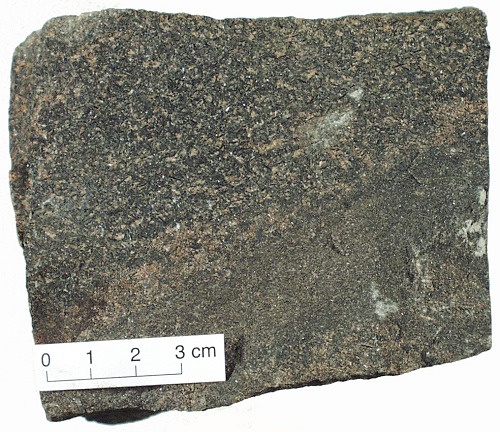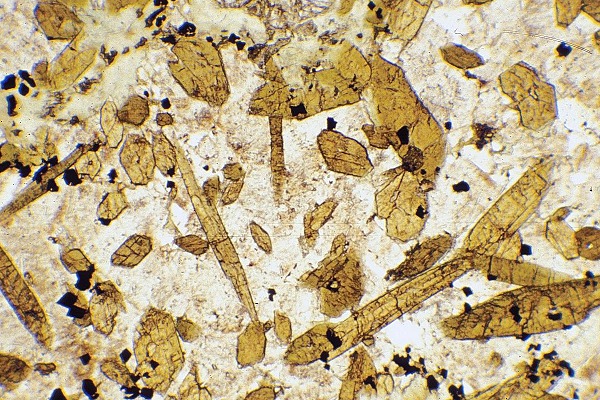
| Home | Geological History | Stratigraphy | Area map | Rock Index | About |
| Scourie | Achmelvich | Laxford | Clachtoll | Stoer | Assynt | Skiag Bridge | Glencoul | Knockan | Borralan | Ledmore |

![]() Hornblende syenite, sill in Durness Limestone
Hornblende syenite, sill in Durness Limestone
Sills are sheets of igneous rock formed when magma forces
its way between beds of sedimentary rock.
In the centre of the photograph a 3 metre thick sill
(the browner-coloured layer weathering into angular blocks)
intrudes
dark grey Durness Limestone near Inchnadamph, Loch Assynt.
The contact is parallel to the bedding in the limestone.

![]() Hornblende syenite, sill in Durness Limestone
Hornblende syenite, sill in Durness Limestone
The rock is intermediate in composition (between acid and
basic) and consists of roughly equal proportions of dark
and light minerals. The dark minerals have a
prismatic shape, i.e. like stubby pencils. The grain
size is intermediate between a deep-seated, slowly cooled
granite or gabbro and a rapidly cooled lava, as might be
expected for a small intrusion emplaced not far below the
surface. In fact, the grain size is finer in the lower part
of the sample than in the rest, suggesting that the sill
was not intruded all in one go, but contains different
pulses of magma that cooled at different rates.

![]() Hornblende syenite, sill in Durness
Limestone
Hornblende syenite, sill in Durness
Limestone
The rock is made up of long crystals of brown hornblende
(some are cut lengthways, some are seen in cross-section)
set in colourless feldspar.
Plane polarized light. Field of view 6 mm across
| Scourie | Achmelvich | Laxford | Clachtoll | Stoer | Assynt | Skiag Bridge | Glencoul | Knockan | Borralan | Ledmore |
| Home | Geological History | Stratigraphy | Area map | Rock Index | About |
D.J. Waters, Department of Earth Sciences, May 2003